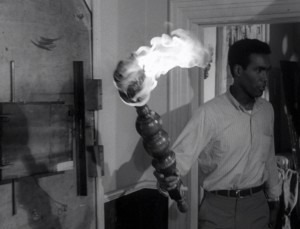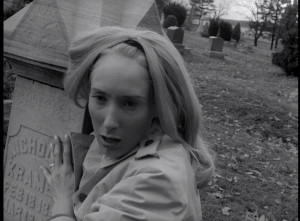With the recent resurgence in popularity of zombie fiction (“The Walking Dead”, “World War Z”, etc), I thought October would be a good time to look back at the series that brought the zombie, as we know it, to the mainstream. The first film in this series being George A. Romero’s independent horror blockbuster, “Night of the Living Dead.”
The plot of the film is fairly straightforward and probably familiar to anyone who’s seen a zombie movie before; a small group of strangers hold up in a building, try to fortify it and wait for the undead apocalypse to blow over. But we find that the real monsters are the humans themselves as society starts to crumble.

Pointing out the trope isn’t meant as a slight to the film, rather it shows how little has changed in the forty-five years that have passed since it first hit cinemas. This isn’t a movie to watch if you want something you’ve never seen before in a zombie movie, almost all of the subsequent ones have borrowed quite liberally from the originator.
What “Night of the Living Dead” has going for it that many later films don’t, is the combination of technical sophistication and thematic subversion that (in America anyway) was almost unique to the cinema of the ‘60s & ‘70s. The acting, while not award worthy by any stretch of the imagination is serviceable and naturalistic. And from a technical standpoint it’s clear that Romero and his crew were not just young kids who’d never shot a frame before. The composition, lighting and overall atmosphere are masterfully crafted. More so when you realize that this is essentially an indie film. And like most indie films, the filmmakers feel a certain degree of freedom and an ability to explore subject matter in a way that bigger budget films may have shied away from.

Specifically Romero uses the horrific situation to examine youth culture’s struggle against authority, the traditional vs. the newly emerging role of women in American society, America’s obsession with “righteous” violence, and of course the much vaunted (if entirely accidental) subtext of race relations in America.
It’s interesting to note Romero’s shotgun blast approach to these themes. He hits them all fast and furiously, never lingering on any one of them too long. It’s as though he feels he won’t get another chance to say what he wants to, and wants to get everything on the screen while he can. It’s admirable, but unfortunately weakens the impact of what he’s trying to do. In some of his later films, he focuses on fewer societal ills and the films are better for it.
Stopping myself from a more in-depth discussion of the subtext before this becomes a retrospective as opposed to a review, I have to ask myself: “Is this a good movie and does it still hold up forty-five years and God knows how many derivatives later?” Thankfully, both answers are yes. Romero proves that he is a master at creating a paranoid and horrific atmosphere. While the tune may be familiar, at a time when we are inundated with reboots, remakes, and revamps, sometimes we can benefit from taking in the original.
by – Jared Moore



2 Comments
Great film to kick off a genre
Pingback: » White Zombie (NR)